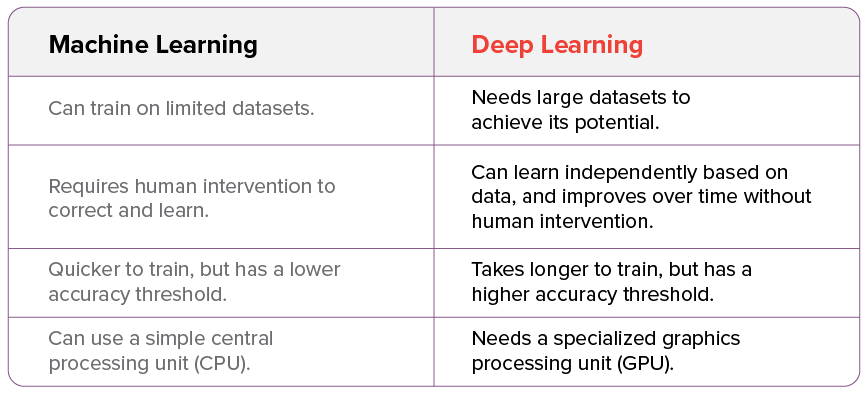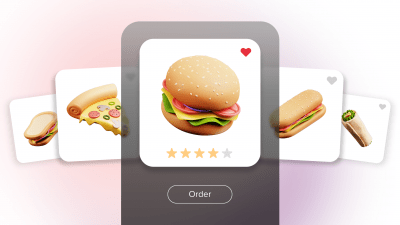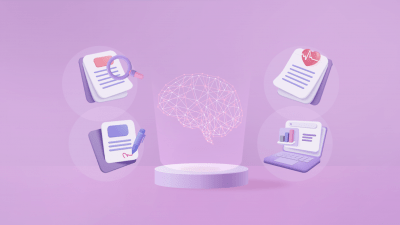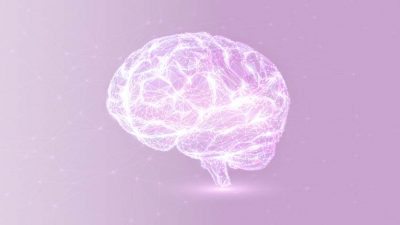Last Updated on: 2nd February 2024, 12:48 pm
We may still be a long way away from anything like the Replicants in Blade Runner, but artificial intelligence (AI) and Deep Learning in particular are already transforming how we approach everything from cancer screenings to displaying ads. ChatGPT and Google’s Bard have made headlines for their eerily accurate imitations of humans. The ability for ChatGPT, and AIs like it, to answer questions and even create functional (if buggy) code has created a media furor that has driven significant investment in AI-focused companies, despite shaky markets.
However, if you dig a little deeper you’ll begin to see that while ChatGPT is really cool, it is just one part of a much bigger picture. Let’s dive in and find out why.
Key takeaways:
- When people say AI, they are usually referring to machine learning or Deep Learning
- Most modern AI breakthroughs are powered by Deep Learning neural networks
- Generative AIs are likely to lead to the AI revolution in 2023
- Deep Learning is an essential tool for advertisers
Table of Contents:
- What is AI anyway
- What is the difference between machine learning and Deep Learning
- Why has AI suddenly hit the mainstream’s radar?
- Our top AI trends for 2023
- Deep Learning is the future and we already use it
What is AI anyway?
Well, let’s ask one, according to ChatGPT:
AI stands for ‘artificial intelligence.’ It refers to the development of computer systems that can perform tasks that typically require human intelligence, such as visual perception, speech recognition, decision-making, and language translation. AI systems use algorithms, machine learning, and deep learning to analyze data and make predictions or decisions based on that data. The goal of AI is to create machines that can perform tasks autonomously, without human intervention, and to improve the efficiency and accuracy of tasks that are currently performed by humans.
That sounds about right to us, although we should remember that often when people say AI, they are actually referring to machine learning or Deep Learning algorithms, which are designed to analyze large amounts of training data in an attempt to find correlations and patterns. Once found, these patterns can be used to help drive a car, identify lung cancer, create a chatbot, or understand what a customer is most interested in purchasing.
What is the difference between machine learning and Deep Learning?
The term machine learning and Deep Learning is often used interchangeably, but there are significant differences.
Machine learning enables computer systems to learn and adapt from experience without explicit programming by using a set of rules, called an algorithm, to analyze data. Within this ruleset, a machine learning system is capable of self-improvement, but if it needs improvement outside this area or if something about the ruleset creates errors, additional human coding is required.
Deep Learning was built to correct this. When something doesn’t work, a Deep Learning algorithm can improve its outcome through repetition, and identify what is and isn’t working. It achieves this by layering algorithms and computing units, called neurons, into an artificial neural network inspired by the structure of the human brain. The data is passed through this web of interconnected algorithms and processes data similarly to our own brains. This enables Deep Learning to process vast, even unstructured datasets, and improve its own set of rules based on its insights.
Deep Learning and machine learning at a glance:

Why has AI suddenly hit the mainstream’s radar?
A large part of this latest rush of interest in artificial intelligence is down to ChatGPT. This app mimics human speech and hit 1 million users in just five days.
Chat AIs capture people’s imagination because they are very good at appearing human. ChatGPT took this to the next level thanks to its ability to propose functional code, and write fairly convincing articles or speeches. This, naturally, led to a slew of pundits proclaiming that AI was coming for our jobs, and generally heightened interest in the field.
There are some issues with this take. While ChatGPT, and other solutions like it, are a big leap forward in AI, they are still not “true intelligence”. ChatGPT is able to provide passable code because it has access to the entirety of GitHub, so it is essentially doing what any inexperienced dev would do, and taking advantage of a resource. It can write speeches, books, and articles because it has access to a vast database of speeches, books, and articles from which to draw from. It is able to learn and produce very convincing content, but not an AI able to fully replace humans in complex work demanding creativity. And it is just one part of a much bigger picture.
With that said, let’s take a look at some AI trends that we think will have a big impact in 2023.
Our top AI trends for 2023
#1 Generative AI will continue to lead the charge
Now that we’ve discussed the limitations of ChatGPT, let’s go back to singing its praises. Generative AIs, like ChatGPT, are any AI that is designed to use data in order to create new content, rather than just analyze existing data. This category also includes digital art generators like DALL-E.
They are popular precisely because they appear to be moving into something long considered the sole preserve of humans: creative content creation. These AI tools make it easier to produce this content and could theoretically eliminate entry-level copywriting and design positions.
As always, this is a double-edged sword. While AI may eliminate some positions, it also creates tools that can be used to help businesses and creatives eliminate some of the early grunt work. For example, a writer may be able to use ChatGPT in order to build a framework for an essay rather than needing to brainstorm from scratch, or a designer can use DALL-E to create some examples for clients to pick from, that can then be used to inform the direction of their final delivered product.
The big thing that we should all look out for is the release of GPT-4. This is the next generation of GPT from OpenAI, which will likely focus on optimization improvements. It has become something of an open secret that GPT-4 is nearly ready. The features are still deep under wraps, but if the hype is anything to go by, it’s going to blow GPT-3 out of the water.
#2 Deep Learning will continue to be applied to novel situations
For us, one of the most interesting moments in AI last year wasn’t ChatGPT, but Meta’s AI Cicero outcompeting 90% of humans in a Web Diplomacy tournament. Diplomacy is a board game where players must actively negotiate with each other in order to gain an upper hand. There is no random component to the game, you simply need to achieve numerical superiority in order to attack, which typically needs the support of another player.
Diplomacy is a tough nut to crack for AI, but Meta managed it. AI has historically been excellent at strategic gameplay, but this was the first example of an AI understanding open-ended negotiation, and actually being able to compete with humans in what is a very difficult playing field.
With generative AIs continuing to improve, we think that it is likely that we will see AIs like Cicero increasingly applied to gaming, business, and even negotiations.
#3 The ethics of AI will become a major talking point
While the fears of AI taking our jobs are largely overblown, there are larger concerns surrounding how our data is being handled. For example, some voices have raised concerns that ChatGPT is built on data that was collected without its creator’s consent. There are also worries that ChatGPT is unable to comply with its responsibilities under GDPR, as there is no clear way to remove individual data from the overall training model.
This has led to the concept of building AI not as a black box, but as a glass box. In many existing AI solutions, users have no idea how an AI model reaches its conclusion, usually due to the complexity of the model. So, researchers have been working on a way to build a complicated AI that can be explained to users (glass box), notably by using an Explainable Boosting Machine (EBM) model developed by Microsoft. Slimmer AI tests using an EBM found that it provided comparable results to a black box model, while also better explaining how it got there.
While it’s important to address any potential ethical concerns and possible dangers, even those that seem very unlikely to happen, we should remember that the opportunity of AI to improve our lives and the world around us makes it definitely worth exploring further, albeit with an abundance of caution.
#4 The cookieless future will reward companies using sophisticated Deep Learning techniques
The cookieless future, and the role of Deep Learning within it, is a topic we’ve talked about before. As Google retires third-party cookies in 2024 and we see a shift towards privacy-first data handling, advertisers will lose access to many of their structured datasets. This will render many existing machine learning solutions even less useful in the very near future.
Deep Learning solutions, like those RTB House already uses, will be better placed to work with these very large unstructured datasets. This will enable advertisers to continue to reach consumers with relevant ads, while also protecting their privacy.
Good to know: The Top 20 Deep Learning Applications You Need to Know
Deep Learning is the future and we already use it
While we’re not anywhere close to creating a truly intelligent AI, we’ve become much better at using algorithms to solve our problems, especially those related to data. This is why it is likely that Deep learning solutions will continue to drive the bulk of AI innovations over the next year or two.
Our team identified the value of Deep Learning early on and we became the first Demand Side Platform (DSP) to adopt Deep Learning in 100% of our advertising solutions in 2017. This gives us significant experience in intelligently applying Deep Learning to advertising solutions, and means that we understand how to help brands make the most of it.
For example, we were able to use Dynamic Video Ads and Deep Learning optimization to help A1 Bulgaria achieve an incremental reach of 485 thousand users, with a video completion rate of 75%. We achieved similarly impressive results for other companies, and you can find the entire list in our Success stories section.
If you’d like to learn more about how Deep Learning can help your business break through barriers, reach out to us today and let’s talk.





